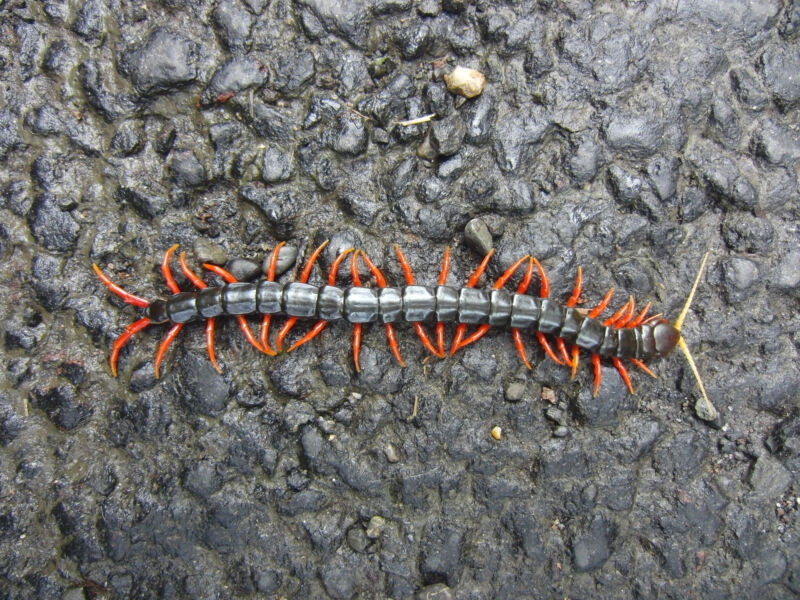Light-sensing proteins are found throughout all domains of life. Even single-celled microbes carry proteins that respond to light. And animals have light-sensitive organs in a huge range of shapes and architectures. All of these seem to operate along the same principles: Photons are absorbed by a protein that responds by allowing ions to flow across a membrane. In single cells, this sets off a regional difference in ion concentrations, allowing them to respond. In more complicated organisms, these ions flow into nerve cells, causing them to signal.
But scientists are describing a weird exception this week: the centipede. These organisms clearly respond to light, as anyone trying to stomp one before it rushes back under a rock or wall will know. Yet many species don't seem to have eyes (and many that have eye-like structures don't sense light with them). And studies of their genome indicate they don't have any of the normal light-sensitive proteins. So how do these arthropods do it?
See the heat
To be clear, many centipede species have things that look like eyes and contain some cells that respond to light. But studies of those organs indicate they have no major impact on the response of the animal to light. And then there's the lack of genes. Light-triggered proteins tend to have similar structures, in part because they have to form channels through the membranes that allow ions to pass through it. So, it's usually relatively easy to pick out genes for these proteins when genome sequences become available.
In any case, many centipede species don't have eyes. And they tend to live under rocks and debris when they're not sneaking into houses, which means they don't necessarily need to see much in their normal environment.
Yet if you expose one of these animals to light, they tend to get out of it pretty quickly, indicating that the animals can sense light. So what's going on?
To figure it out, a team of Chinese researchers set up a system where they could expose centipedes to light and test their responses. The imaging by this system showed that the antennae have a distinctive pattern in the infrared: they heated up in the light. In about 10 seconds, the temperature of the antennae went up by over 8° C, much faster than any other part of the body.
The other appendage—and there are a lot of legs to image on these things—did not. And, don't ask me how they did this, but the researchers put a tin-foil hat on the centipedes, blocking their antennae. This greatly reduced their ability to find darkened areas. Overall, this led the researchers to suspect that whatever was going on with the light sensing, it was happening in these organs.
An unusual gene
The researchers next decided to identify the gene involved. To do so, they isolated copies of all the active genes in the antennae. They then identified those with segments that can cross the membrane, since the protein has to allow ions to do so. This cut down the list of possible genes from over 8,000 to just a bit over 1,000. At that point, the researchers just started putting the genes individually into human cells until they found one that allowed ions into the cells at elevated temperatures.
The gene that worked was called BRTNaC1, and it's somewhat distantly related to a known family of ion channels that allow sodium ions into and out of cells. But that family isn't sensitive to temperatures. And BRTNaC1 isn't picky about what ions it lets into cells; it'll happily allow calcium to pass across membranes as well.
After testing various chemicals, they found that testosterone inhibited the activity of BRTNaC1. This is not biologically relevant, as insects do not make testosterone. But it's certainly convenient because you can apply it to the antenna without having to worry about it altering the bugs' behavior. So the researchers treated the centipedes with testosterone and then tested whether they were still sensitive to light. They were not.
All of which indicates that these animals sense light without directly registering any photons. Instead, they sense it very indirectly, with an organ that selectively heats up when exposed to light, allowing the animal to sense that temperature change. So far, this is the only example of this that has been identified. It's possible that these centipedes are one-of-a-kind in terms of this biology.
There are two striking things about this. One is that there are many known proteins that organisms use to sense temperatures, like the ones that cause us to pull our hands away from hot stoves. But BRTNaC1 isn't closely related to any of them. So it seems to have evolved completely independently. The second thing is that we have no idea how the antenna is structured so that it selectively heats up.
PNAS, 2019. DOI: 10.1073/pnas.2218948120 (About DOIs).



3175x175(CURRENT).thumb.jpg.b05acc060982b36f5891ba728e6d953c.jpg)

Recommended Comments
There are no comments to display.
Join the conversation
You can post now and register later. If you have an account, sign in now to post with your account.
Note: Your post will require moderator approval before it will be visible.